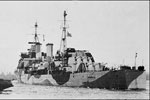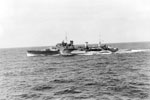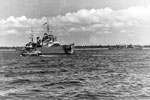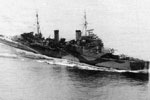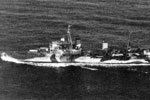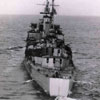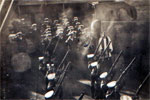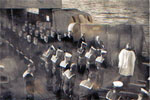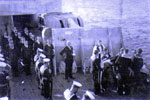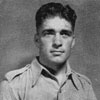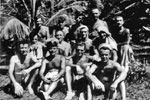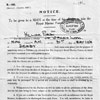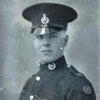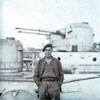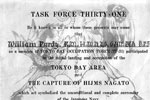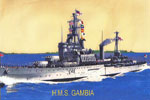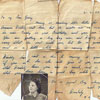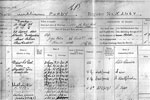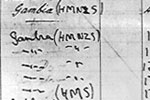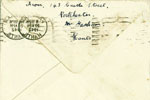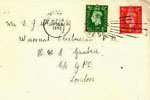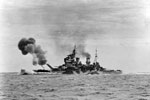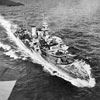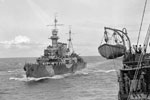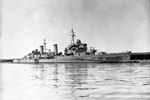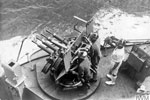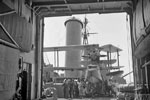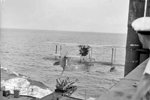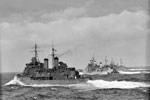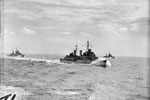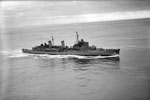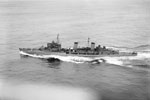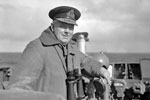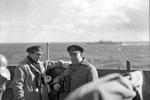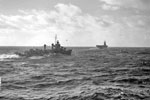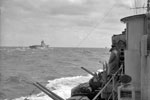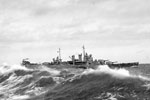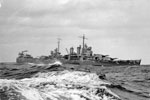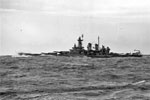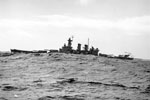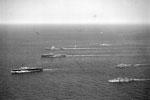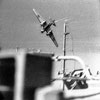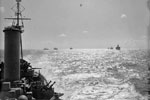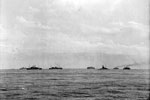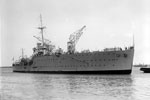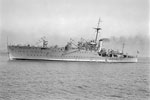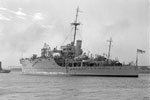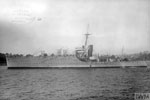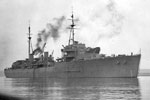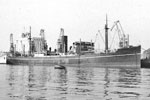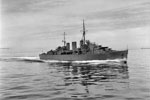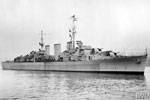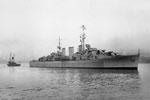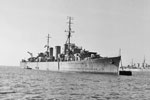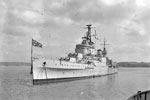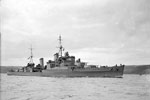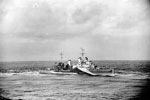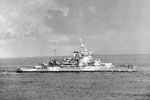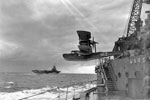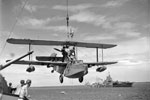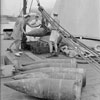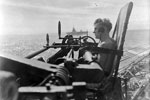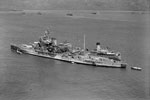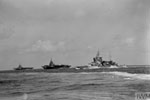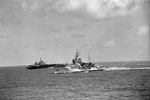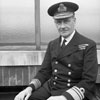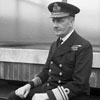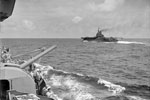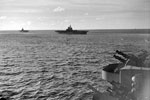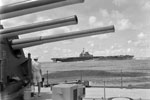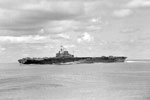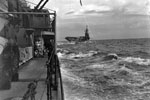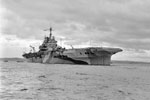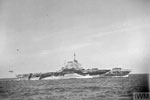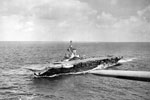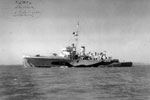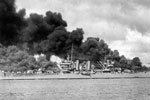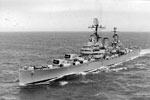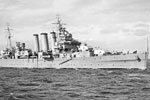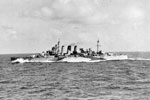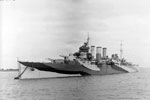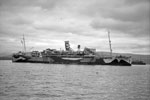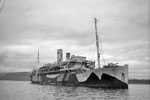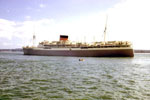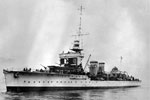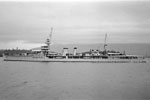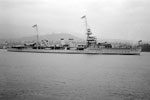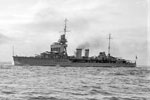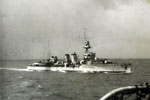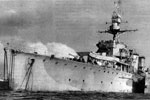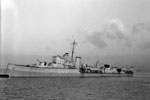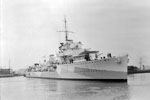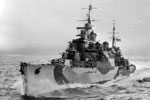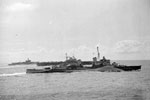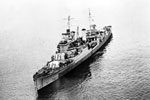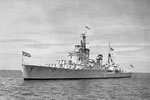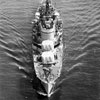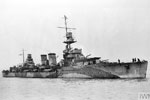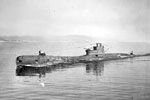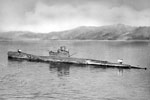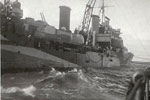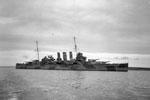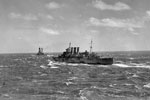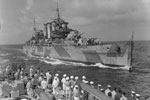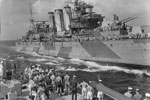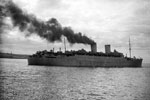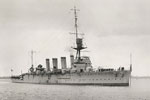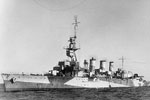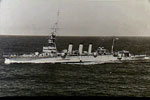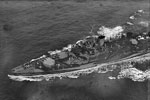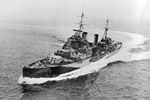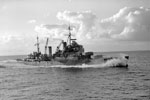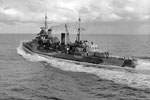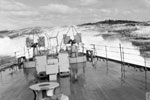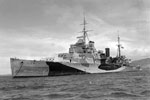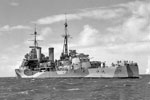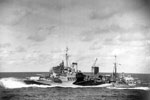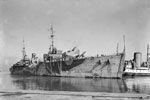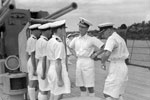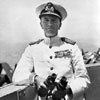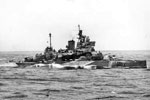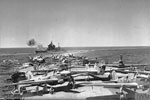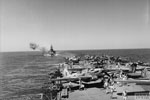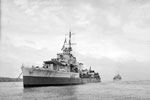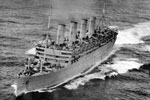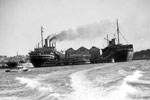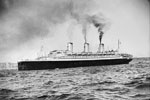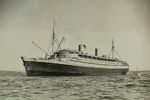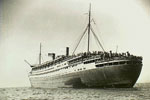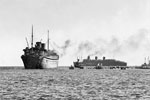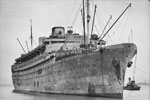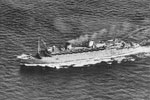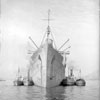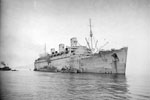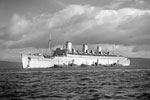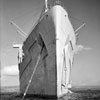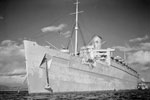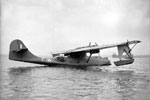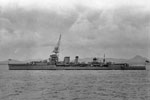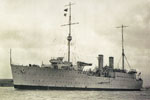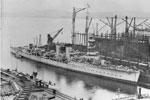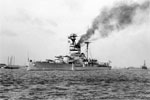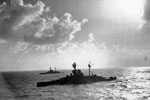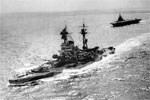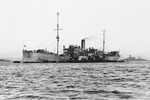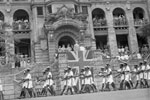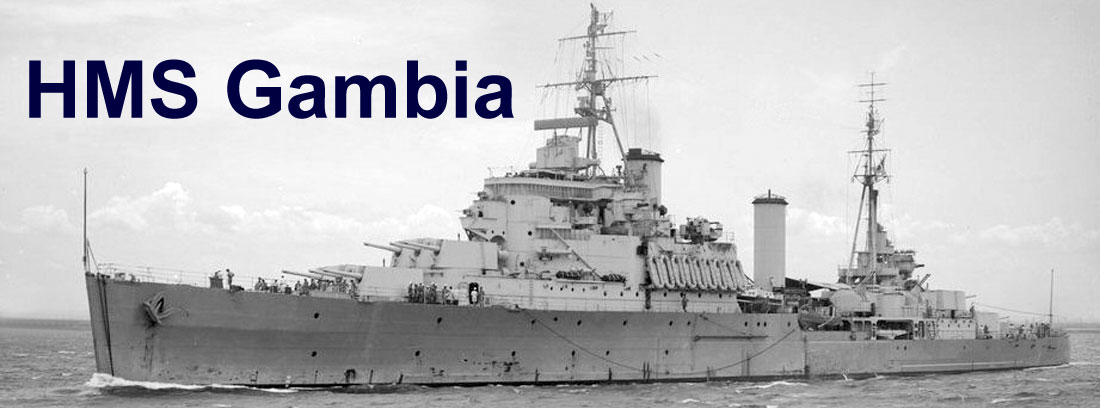
The 1941 to 1943 Commission
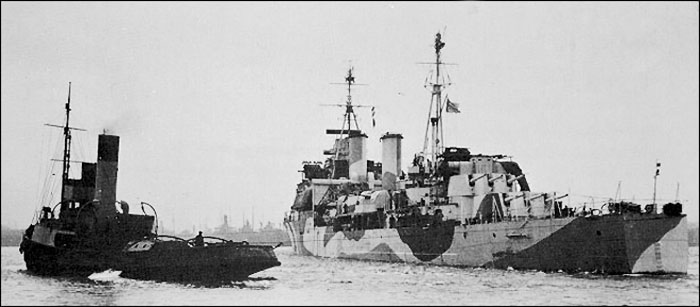
HMS Gambia being towed out - February 1942

HMS Gambia in WW2 guise, note the Barrage Balloon in the top right of the picture. It is also signed by Captain Maurice James Mansergh, RN who was captain of HMS Gambia from November 25, 1941 to June 23, 1943. The image was kindly sent to the HMS Gambia Association by Eric Delderfield who was on the first commission.
94 year old Eric Delderfield remembers WW2 at a 2013 HMS Gambia Association dinner
Here's a transcript of the video:
And to the girls who obviously weren't in the war years, thankfully. Though I would like to say a just few words about my family not me so much but obviously I'm going to be a part of it. I am the ninth of ten children. My older brothers Fred, Wilfred, Frank, Arthur, Ted, Alice, Elsie, as you can see, it goes on a bit, and that's about six of us, we were all in the navy, and at one time, we were all at sea.
I met my brothers, in various parts of the world, we won't go into the details, except I was walking up one side of the road, and my brother Frank or Ted, not Ted so much as Ted was killed in HMS Formidable in Crete. He was the only one on board at that particular time that was hit. He was in his turret, doing whatever they did in the turrets and unfortunately it killed him outright. So we lost brother Ted.
Brother Wilson was also a survivor, I can't recall the name of the ship, in Egypt. Brother Frank was also on the Southampton, badly wounded, so I thought over all these years whatever did my mum think, what was going through, back home and quite honestly it never occurred to me. As indeed most of us who was in our situation where we were at the time.
I was on the Gambia for two years, from the start to the finish of the first commission. It was the first ship I had encountered with. I was completely lost as indeed most of them were because at the time the crew was made up of 95% amateurs. We were amateurs. Even the officers were amateurs. I remember on many occasions, especially at the time we were waiting for the Germans to invade us, it was a real fear. No doubt about it, we knew, well we thought we knew, we were told, one or two of us, me included at some point said to whoever it was, it was an officer, "what do we do?" and all he said was "they'll be coming down in thousands, shoot 'em. Just kill them and get on with the next one. Shoot 'em."
Bear in mind we just got out of Civvy Street, and complete idiots. We didn't know what was happening, but we were told, not so much told because we all knew they didn't know as much as we were. So just what do you do, and indeed the answer was shoot 'em.
Anyway, that's all part of the situation we found ourselves in. There was never, ever a situation that masses of servicemen as indeed we were, we were supposed to be servicemen, I can't think of how many times I had to remind myself. We knew nothing, but the threat was real. No doubt about the Germans were five times better fighters than we were, as they were heavier.
As a point of interest, anybody at Chatham Barracks at that time?
Not at that time, long after.
Go to a part of the barracks, and I'm trying to recall the name now, but whatever it was, it was "how to fire the gun." I had a rifle, I had a bayonet, I looked the part, bloody useless. We all were, we didn't know what the hell we were supposed to be doing other than shoot 'em. I thought to myself, "well, if I'm going to go, I'm going to take someone with me."
I can see it after all these years, as if it was happening yesterday. But, I do find it difficult at times just to accept the fact that that's what we were walking into. We knew nothing except that we were told time and time again "Shoot the Germans." I think it was about February 2nd, 1942, that we joined the Gambia. I'm pretty sure of the date.
That was something else, bear in mind I was in the army basically two years. There were no ships available for us to run. What are we going to do with them? I was based somewhere in Kent, [Ashford?] that's where the Germans would have come in had they started to invade. He (King George VI) was inspecting the troops, we didn't worry too much about him, he was bloody useless anyway. "What's he doing here?" He was looking up and down the lines and there must have been a few hundred of us. He didn't exactly laugh at the blokes, obviously he wouldn't have been in a position to do so, but he was quite surprised to see sailors, dressed as sailors of course, but acting as soldiers, which we were. Anyway, that's by the by. We got a congratulations for how smart we looked and all this business. We were only 20 years old, so eventually, I was certainly there for the best part of two years. We were ready to pull the trigger, but nothing happened. We didn't know of course, as it was the situation we were in before.
Eventually I learned that my brother Ted has been killed earlier on, on Formidable. I volunteered and that's how I picked up the Gambia and I was on her for two years. I travelled the world a few times as you might well imagine, as indeed most of you have done the same. So, nothing special about that, it's just the fact that I did a lot of sea-time. I must tell you before I sit down again, HMS Gambia, we played Gambia at football and we beat them, but the point was, the natives of Gambia said that they'd bought our ship and that the kids, thousands of them, were entitled to our ship as they had paid for it. We beat their national team, 3-0.
Most of us thought a little way ahead how many German U-boats were waiting for us to come out. They knew damn well where we were. Everyone in the world knew where the Gambia was. Most of us, the majority of us, were very wary about the fact that the ship would come out on the way home, and fully expected to meet trouble. Knowing full-well of course that these thousands of kids were telling the whole world they were expecting HMS Gambia.
We've all got our own stories to tell. Some is unbelievable, most of it is the truth, but there's always a bit of embellishment along the line somewhere. If I might add, for any of us, in a position to do so, to jot down a few things what's happened. I've got some bits and pieces from 1942.
Thanks for listening to me rattling on and I hope I'm in a position to see you all next year.
Bill Hartland wrote that "Sadly, not long after this speech from Eric, he passed away, so a sad loss to the HMS Gambia Association. I was privileged to precede the cortege along with the Association Standard Bearer to the Entrance of the Church, where Eric was committed for cremation. Eric was an LTO on HMS Gambia, and the LTO was a Torpedo Operator, so not anything to do with Telegraphy which some folks thought he was a Leading Telegraphist Operator. He was actually a Killick in charge of a weapon which should have been managed by a commissioned officer, not the equivalent rank of a corporal in the Army. Rest in Peace Eric, sadly missed."
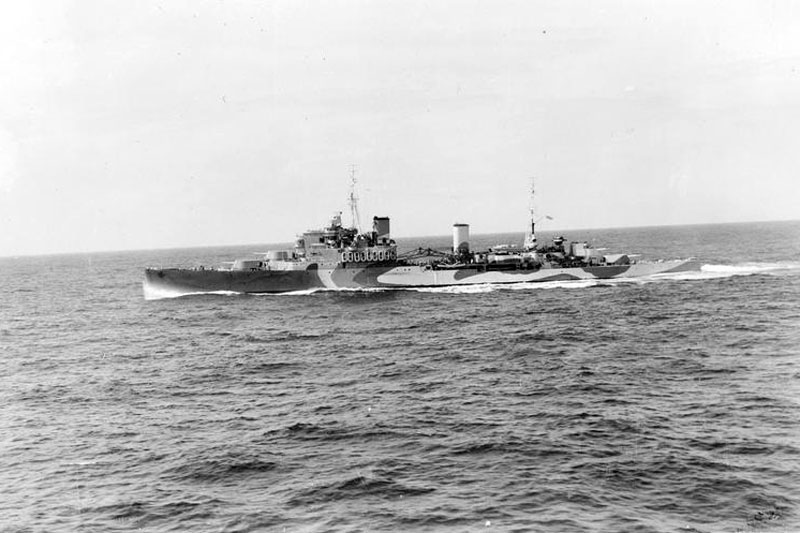
HMS Gambia. August 1942. Photo: Lt. H. A. Mason. Imperial War Museums A 12925
The destroyer depot ship HMS Hecla was launched on Clydebank in March 1940. After service in Iceland, she was on her way around the Cape in order to join the Eastern Fleet in May 1942 captained by Edward Francis Bold Law. Doggerbank, a German minelayer had recently laid eighty mines off the extreme southern point of South Africa around Cape Agulhas. and it was one of these that Hecla struck on 15 May 1942. The mine exploded beneath her huge workshop and storeroom also damaging her steering gear, killing twenty-four men and injuring another 112.
She was taken in tow by the cruiser HMS Gambia under the command of Maurice James Mansergh CBE with the SANF (South African Navy Ship) minesweepers, Southern Barrier and Terje, going on ahead. Hecla was towed into Simonstown for repairs. Hecla's dead were buried at sea from HMS Gambia in False Bay, Simonstown.
The repairs took 18 weeks and she did not leave until September 1942. Just two months later Hecla was sunk by torpedoes fired from the German U-boat U515 in the Straits of Gibraltar during Operation Torch on November 12, 1942, with the loss of 279 of her 847 crewmen.
The story of HMS Hecla can be found on the Holywell House Publishing website and more on UBoat.net

HMS Hecla under tow during WWII (It is unknown if this was connected to the above incident) Imperial War Museums FL 22892
These photos of Royal Marine Len Bloomfield were on the original HMS Gambia Association page...
Unfortunately other pictures of Len and his fellow Royal Marines were not captured by the Web Archive from the original website.
Bill Harland said that Len served on various ships, and that he was moved around quite a lot following promotion and his expertise in training others in gunnery.
Willliam Purdy - Royal Marine
Royal Marine William Purdy X2467, was attested into the Royal Marines in Derby on May 31, 1938. He spent a long time on HMS and HMNZS Gambia, from February 4, 1942 to July 11, 1946. As well as Gambia he also served on HMS Resolution and Kenya. He sadly passed away in 1982 after suffering many years of illness as a result of being on board two separate ships blown up, including the torpedo attack on HMS Resolution (September 25, 1940).
King's Badge
On March 7, 1918, His Majesty King George V visited the Depot Royal Marines, at Deal in Kent. On this occasion he inspected Royal Marines Recruit squads, and took the salute of the 4th Battalion at a March Past. Six weeks later the 4th Battalion were to storm ashore on to the Mole in the raid on Zeebrugge, where they won great fame and two Victoria Crosses.
To mark his visit, His Majesty directed that the senior Recruit Squad in Royal Marines training would in future be known as the King's Squad. He also directed that his Royal Cypher, surrounded by a Laurel Wreath, would be known as the King's Badge, and would be awarded to the best all round recruit in the King's Squad, provided that he was worthy of the honour. The badge was to be carried on the left shoulder, and worn in every rank. Her Majesty Queen Elizabeth II was graciously pleased to approve that the custom and privilege of the King's Squad remain unaltered. The King's Badge is not awarded to every squad, and is only presented if a Recruit measures up to the very exacting standards required.
I am very grateful to his son, Garry, who sent the information and images for this page.
Eric Palmer - Able Seaman
I joined Gambia in September 1942 together with some 750 men - regulars, conscripts a fairly mixed bag. After an initial shakedown and appointment duties, we sailed on our first mission - torpedo trials on Loch Long, a beautiful Scottish Loch - but cold, cold! Thence on to Scapa Flow for our final sea trials, again - cold, cold! Then blessedly into the warm South Atlantic bound for our final destination Mombossa, East Africa, and base for the Far Eastern Fleet. St. Helena, Freetown, Cape Town, Durban and finally Mombasa, which was to be our base for a year.
Gambia was a happy ship under the command of Captain Mansergh, a great gentleman always courteous to all ranks (unless you put a foot wrong, of course). I had some personal contact with him, as I was, for a while, detailed to clean his quarters and never felt ill at ease in his presence. Even after 60 years, I still remember him with respect and affection.
Now, back to Mombasa. The Far Eastern Fleet comprised ships from half the free Nations of the World, Dutch, Free French, Norwegain, Canadian, you name it, they were there. Gambia was a bit of a dogsbody in the Indian Ocean, watchdog against roving Japanese, countless convoys, missions to the Seychelles. We crossed and recrossed the equator regularly.
We also carried a contingent of Marines including a very fine band. Myself and my old shipmate "Hutch" (who has remained my friend over 60 years) were both musicians and were welcomed into the Marine Band. There was a wealth of talent on the Gambia and we gave regular concerts in the Aircraft Hanger. Where ever we stayed for a refit the locals usually threw parties or dances for the Officers at which we supplied the music - a pleasant pay-off for our musical abilities!
I must now recount the Battle of Tamatave! Madagascar, a strategic island off the coast of Africa was then in the hands of the Vichy French and although there had been a reasonably successful British landing in the North, parts of the island remained in Vichy hands. So, a veritable Armada sailed to subjugate the regional town of Tamatave. We stood a fair way off shore and demanded that they surrender - without response! The call was repeated and again ignored and we were then commanded to fire one round apiece. I was in one of the forward 6" gun turrets apprehensively awaiting the scream of enemy shells! Well, the Armada fired its round and knocked out the Lighthouse and about one thousand Date Palms! Eventually, a lone figure came pedalling down the jetty on a bicycle bearing a White Flag! so ended The Battle of Tamatave!!
The ultimate achievement of our duties in the Indian Ocean was to convoy forty thousand Australian Troops from the Middle East back to Australia. This had to be the mightiest convoy of the Second World War. All the Great Liners of the World had been commandeered to take them home to Freemantle, Western Australia. Isle De France, RMS Queen Mary, SS Amsterdam, Normandie and others I can't remember plus an armada of guarding warships comprised the convoy. In retrospect it was a logistical miracle to convoy an entire Army safely across a dangerous sea without loss of man or ship.
We stayed in Freemantle for quite an extensive refit, prior to sailing back to England. I fell in love with Australia on the spot and after many vicissitudes, returned with a wife and son in 1948 to spend the rest of my life in this wonderful Country. Gambia returned to England sometime in July 1943 to a cold, bleak Liverpool day. My last and final memory of the Gambia was of Gangway Duty to witness the final humiliation of our lovely new ship being fumigated against bed bugs, cockroaches and other nasties collected from our friends of the Far East!
I won't be reconciled to her being turned over to the New Zealand Navy (Australians aren't all that keen on Kiwis!) In my recollection she is still as she was when I left her in 1943. If there are any of my shipmates still alive and I guess there are not that many, please forgive any lapse of memory of an old A.B.
Envelopes addressed to David Jenkin Wadey, dated April 20, 1942 and September 25, 1942. Wadey is mentioned in the Navy Lists for October 1940 and June 1941 as Acting Warrant Electrician.
A War Diary
The following diary was on the original HMS Gambia Association website. Apart from reformatting it for this site I have made no further edits to it. However, I do believe that some of the details in the diary were not recorded correctly. For example, I cannot find any record of a SS Sudan being sunk in May 1942. There was however a feighter SS Soudan that hit a mine in convoy WS18, the same one that HMS Hecla was in when it too hit a mine. Apparently, the WS stood for "Winston Special."
SS Soudan (6677 BRT) was fortunate in suffering no casualties. She hit a mine off Cape Agulhas near Cape Town, South Africa on May 15, 1942, but remained afloat for most of the day. In a way she was lucky, her Master reported that on examining his ship after the explosion he found "No 2 Hold empty, the bottom having apparently been blown out and the stores loaded in that hold having fallen out of the hole." This was fortunate as the stores included 400 tons of TNT.
There have been several ships named Soudan since 1850. The best I can come up with is that this one was owned by P&O and built in 1931. P&O have owned three ships named Soudan, the first of these, built in 1901, was sold to Japan in 1925. That one was used as a troop and hospital ship in WWI. The last one was built in 1947 and scrapped in 1970.
From the original HMS Gambia Association website: "The following text is a copy of the draft diary kept by a crew member, who may have been a Stoker - no offence towards Stokers implied, so please accept the following as being a true description of events. The thumbnail photographs are of the Ships involved in the Story, so that one may get the feel of the narrative, which is sketchy in parts and some is unreadable so that the editor has supposed and applied some text of his own. I have also made some edited changes thanks to the observations of Brian Millo, so that Killiding, is now changed to Killidin, which is located near Mombasa, Kenya."
Following Bill Hartland's lead on the original website, I have tried to include Public Domain or Creative Commons images of the ships and people mentioned, where possible from the time that the diary covers.
HMS GAMBIA C48 FIJI CLASS CRUISER
A Stoker's Diary of Events
Memories of one of the first Crew Members, which must have been written under the most arduous conditions.
Stood by ship from November 16th 1941. Ship commissioned February 4th 1942, all leave stopped while ship was alongside Anson at Swan Hunter. Left Swan Hunter for North Shields at 11.00hrs on February 8th arrived Rosyth 19.10hrs, had a few days in and out of gunnery.
Monday 2nd March 1942 Left Rosyth 05.30hrs for Scapa Flow arrived there at 18.00hrs, all that month in and out of harbour and gunnery, finished running in Monday 30th March, now a fighting unit.
Wednesday 1st April 1942. Went out on exercises with Frobisher and H.M.S. Edinburgh came under command of the Admiral on Edinburgh the 18th Cruiser Squadron. After exercises went to rendezvous with American Fleet.
Thursday 2nd April Met up with Yank fleet lovely trip, lots of eight meals a day.
Friday 3rd April Left Yankee fleet with the Edinburgh, us and the Frobisher, proceeded to Greenock to give 72 hrs guns.
Saturday 4th April Arrived Greenock 10.00hrs.
Tuesday 7th April Went on leave the Froby’ had the same special train at Carlisle.
Thursday 9th April Came back on late train to the wide, roll on civvy street!
Friday 10th April Arrived onboard at 09.30hrs, as usual fed up! The second leave went in the morning.
Monday 13th April Second Leave arrived back onboard.
Wednesday 15th April Proceeded to sea with big convoy of troops also we were in charge of the convoy, whilst at sea Captain tells us first stop Freetown we have an important convoy 40,000 troops and cargo boats with material, also the Hecla and a destroyer repair ship in the convoy.
Friday 24th April Destroyer came alongside for oil, weather lovely no incidents but fed up of looking out to sea, shot our aeroplane off the spotting duties, we have crossed the equator wearing tropical rig now, weather lovely but hot. Fed up of looking at the sea, roll on Freetown!
Wednesday 29th April Arrived Freetown that’s 14 days at sea sent letters off also a cable as I know my wife will be worrying, so am I fed up of this party? Some of the lads went ashore, ships a disgrace when they came back, had to climb up a Jacobs Ladder at the ships side as some of them had a drink too many and had to be carried up. The gangway was down aft but for officers only and wonders why people are fed up. Commander stopped a hatchway with his head, left him on hospital ship.
Sunday 3rd May Left Freetown, 3 more ships joined convoy also the aeroplane ship Albatross. Troopship Agweleon full of Yank troops also with the convoy she is, (lame duck).
Monday 4th May Destroyer came alongside to oil her. Got fresh spuds onboard as we had mice in box of spuds. After oiling destroyer proceeded to pick up convoy, lame duck left convoy to put in for fresh water and Froby’ went with her.
Thursday 14th May Convoy split up half of them gone to Cape Town with the Albatross and destroyers us and the others heading for Durban.
Friday 15th May H.M.S. Hecla stops a Mine, 8 dead and 90 injured. We escort her to Simonstown.
Saturday 16th May Arrived Simonstown with Hecla casualties, now 17 dead, 7 missing and 140 injured.
Sunday 17th May They fetch 17 dead onboard off the Hecla to be buried at sea. Proceeded to sea at 25 knots to look for survivors of S.S. Sudan as she is also reported as being mined, but can find no survivors.
Monday 18th May Captain tells us we are now bound for Mombasa so some more sea time in, still no news of survivors from Sudan, sent a letter off at Simonstown am longing to get a mail, working until 01.30hrs oiling ship, roll on the end of this lot, lets get back home.
Saturday 23rd May Arrived Mombasa at 10.00hrs went alongside to oil stopped alongside all night. Plenty of ships in here. Went ashore to see if I could buy anything but prices too dear the place is full of sailors.
Sunday 24th May Left the wall at 06.00hrs went to anchor in the harbour. Destroyer came alongside to stop, then she went to sea with the Manxman.
Monday 25th May Still in harbour, what a change but I don’t know how long for.
Tuesday 26th May Admiral came onboard at 09.0hrs, tells us we come under his command the 4th Cruiser Squadron he is on the H.M.S. Newcastle. 11.30hrs, Admiral Somerville came onboard from the H.M.S. Warspite, he is the C in C of the Station tells us to expect a hot time so goodness knows when we will get home.
Wednesday 27th May Left harbour with H.M.S Newcastle and 4 destroyers had AA shoot also night encounter good shoot.
Thursday 29th May Came back into harbour at 09.00hrs. Ecclestone went sick and I had to pick his watches up, oiler came alongside at 18.00hrs finished oiling at 21.00hrs.
Friday 29th May Left harbour at 12.30hrs with two aircraft carriers, Illustrious and Formidable also Warspite and 6 destroyers, had practice shoot and night shoot attack weather lovely.
Sunday 31st May Watched aeroplanes attack Warspite the planes were from the two carriers, no sign of going back to harbour yet.
Monday 1st June Still no sign of going into harbour.
Wednesday 3rd June Still at sea been on our own for two days but the Warspite and two carriers came up today. Had sleeve target shoot all ships took part.
Friday 5th June Aircraft came out from Colombo to attack, repelled by aircraft from the Carriers. One plane from Illustrious came down in the water lost plane and men. Arrived in Colombo at 15.30hrs went alongside oiler then alongside Illustrious. One week in harbour the longest we have had since we were commissioned.
Friday 12th June Left Colombo at 09.50hrs all the others left with us, the Warspite and the two aircraft carriers also 5 destoyers, have heard that Frobisher has stopped a Tin-fish.
Saturday 13th June At Sea the C in C has sent a message to say that there are enemy supply ships about to supply to subs. reconn: planes are having a look at the Chatos islands if there any there we have to do our stuff. Plenty of planes doing patrol duties.
Sunday 14th June Still at sea, everything o.k.
Tuesday 16th June Went into Abdul Atoll islands at 09.30hrs, and went alongside oiler. Every ship oiled and left again at 16.00hrs.
Wednesday 17th June Had practice shoot at aeroplanes off carriers our plane shot down, our life boat piped away to pick up the two airmen who were floating it was a rotten disgrace the airmen were struggling in the water and the gunnery officer had to ask for permission to slip the lifeboat. The airmen had to swim to the lifeboat if they had been injured in the fall they would have been drowned before our own boat could have got to them.
Thursday 18th June Arrived back at Colombo at 17.00hrs went alongside oiler that was alongside Illustrious.
Friday 19th June Left Illustrious and went to another buoy of our own.
Saturday 20th June H.M.S. Shoreham a Sloop, came alongside to stop.
Monday 22nd June H.M.S. Shoreham left at17.00hrs.
Tuesday 23rd June Left Colombo at 09.00hrs went into boiler room watch keeping, got a shift from the stores, in the dog watches starboard forward circulator broke down got seized up E.R.A.’s working on it three watches. (Noted here that one of the E.R.A’s was our President, Chief ERA Arthur Robinson. Forged the retaining nut for the shaft, 4" BSW, quite a job.)
Wednesday 25th June Circulator going again alright now. The Warspite and other ships left us; we had a night attack by planes from the carriers four of the planes went straight into the water! After the shoot we turned around and went back to Colombo on our own Special Job, the remainder went on to Mombasa.
Sunday 28th June Arrived Colombo at 01.30hrs oiled ship.
Monday 29th June My dear wife’s birthday, wish to God I was with her, fed up with this party! Wednesday 1st July Went to sea at 09.30hrs Ceylon was supposed to follow us out to come to attack us, the Gunnery Officer said they did not want to play so we stopped out all night and wasted oil and fuel.
Thursday 2nd July Came into harbour on Colombo at 15.30hrs back to the same position.
Saturday 11th July Went on a trip up to the rubber and tea plantation 40 miles out of Colombo with the parson and his wife who were the manager they came from Leeds, the place was called Betsoda.
Monday 13th July Left Colombo at 14.00hrs with convoy of Aussie Troops, the Captain says we are taking them part of the way to Australia as they are going on leave, an American Cruiser is supposed to meet us about Sunday and take the convoy off us then we will be off somewhere else.
Friday 17th July During the evening had an operation on a young R.D.F. rating for appendicitis the weather non too good for it as we have had monsoon weather since we left but the operation went O.K. The lad doing well.
Sunday 19th July The lad is still doing well after the operation. We meet the American Cruiser USS Phoenix, she took over the convoy at 12.15hrs, we steamed down the convoy with the Aussie Soldiers giving us a cheer as we left them to proceed on our own.
Wednesday 22nd July Arrived at the island of Mauritius went alongside oiler at 10.30hrs left again at 15.50hrs, after oiling once again off to somewhere.
Thursday 23rd July Captain told us we were going to Durban, at 12.00hrs went alongside oiler gave leave from 16.30hrs to 23.30hrs, went ashore and had something to eat, ship under sailing orders. The mail has arrived onboard the first since we left home, a small one but better than none at all.
Sunday 26th July Left Durban with big convoy of troops more ships picked us up outside got a shake during the afternoon given a telegram, a daughter born and both well good luck my love, I feel easier now. The Captain tells us we are turning over this lot at Mauritius to the Shropshire. We take one ship out of the convoy then oil and proceed East with this one ship.
Thursday 30th July 09.00hrs came in contact with H.M.S. Shropshire and armed Merchant Worcestershire, they took over the convoy. We took the Sterling Castle with us.
Friday 31st July Arrived Mauritius at 10.00hrs we went into oil, left the Sterling Castle outside finished oiling then left again at 12.30hrs, picked up the Sterling Castle and came to our rendezvous.
Saturday 1st August Eased down to 9 knots engine trouble on the Sterling Castle.
Sunday 2nd August Increased speed to 15 knots engine repaired on Sterling Castle.
Wednesday 5th August The Captain gave a short speech tells us we have travelled 33,000 miles in 6 months not bad going.
Thursday 6th August Came into contact with Dutch Cruiser she took over the Sterling Castle, we have turned about and going back to Mauritius to oil.
Sunday 9th August Captain says we have to call at Rodriguez Islands to pick up 3 Dutchmen who have escaped from the Japs in Java, we increased speed to 25 knots, we are also going to Killidin after oiling at Mauritius.
Monday 10th August Arrived at Rodriguez at 16.00 hrs, the three Dutchmen came onboard, left again at 16.10 hrs.
Tuesday 11th August Arrived at Mauritius went alongside oiler took on more passengers for Diego Suarez stopped the night.
Friday 14th August Arrived Diego Suarez in Madagascar at 09.00hrs about six ships sunk in harbour since we took it off the French, got some soldiers onboard to take passage, they were here with invasion. Left again at 11.30hrs H.M.S. Dragon still here.
Saturday 15th August One of the Dutchmen gave a talk over the wireless (the Ships Set, S.R.E.) about their escape from the Japs at Baltaria. They were at sea 31 days on a 21ft sailing boat before they made Rodriguez Islands, very interesting talk.
Sunday 16th August Big mail. Arrived Mombasa at 09.00hrs oiler came alongside at 14.30hrs.
Monday 17th August Started boiler cleaning.
Tuesday 18th August H.M.S. Nizam came alongside, Stoker I knew on the Nestor.
Thursday 20th August New commander arrived, Riley ex-P.T.I.
Sunday 23rd August Stopped bathing on the beach, have to bathe over the side, mail arrived, I had one letter.
Tuesday 25th August Went to sea for gunnery drill stopped out all night.
Wednesday 26th August Back in harbour at 16.00hrs.
Saturday 29th August Left harbour for exercise invasion of Islands (?).
Sunday 30th August Arrived islands made the invasion believe it was a failure left again at 18.15hrs.
Monday 31st August Arrived back at Killidin At 08.30hrs.
Tuesday 1st September H.M.S. Blackmore came alongside to oil then left.
Wednesday 2nd September H.M.S. Arrow and Active came alongside.
Thursday 3rd September Anniversary of War, a day of prayer, what a farce lets get it over with. Active left we have two passengers for Madagascar.
Friday 4th September Left Killidin with 2 destroyers for Diego Suarez, at 11.00hrs passengers left ship, we oiled in the afternoon.
Monday 7th September Left Diego Suarez with convoy of troops and ships in the convoy Captain tells us we are meeting another force and are going to take Maujunga off Vichy French as it has been used as an enemy submarine base.
Tuesday 8th September A news correspondent left the ship at sea to go on a destroyer taken camera and a lot more gear.
Wednesday 9th September Met the other ships also the Illustrious, Birmingham with the Admiral onboard, also Major General Stirgess of the Marines is in charge, hell of a lot of merchant ships with troops destroyers also the Albatross Seaplane carrier. The bombardment and raid starts 01.00hrs tomorrow so the time is drawing near now it will be a big thing as the sea looks full of ships.
Thursday 10th September We stopped outside to protect the Illustrious the Captain says the landing was made on one part at 01.08hrs this morning capturing the Post Office, Bank and Wireless Office; more troops were landed at 05.30hrs this morning not much resistance advancing towards aerodrome. Our Walrus shot off at 05.30hrs this morning to do submarine patrol at the entrance of the harbour. So far there have only been 40 casualties. There has been three places attacked, some troops came down from Madagascar as it is on the same island.
Friday 11th September Still outside with Illustrious, hears about the raid on the wireless making way back to Diego Suarez. Left Majunga at 15.30hrs.
Saturday 12th September Arrived Diego at 11.30hrs with Illustrious and three destroyers went alongside oiler.
Sunday 13th September Left Diego at 16.15hrs the Captain tells us we are to pick up another convoy of troops and take them to the other side of the island to attack Tamatave the capital of Madagascar.
Monday 14th September Picked up 7 ships in company of Seaplane carrier Albatross and H.M.S. Dauntless they had come from Majunga the ones we took there. The Dauntless left and we carried with convoy to have a crack at the Capital. R.A. Captain came onboard. Admiral came onboard of the Birmingham had a conference with the Captain, then we carried on out again, met up with the convoy again at 16.30hrs, the Dauntless was with them.
Wednesday 16th September Heard on the wireless the capital Tamatave had asked for an armistice, but we have got all ready to open up on arrival at dawn on Friday.
Thursday 17th September The Sea half full of ships, the Warspite, Illustrious, Birmingham and a Dutch Cruiser and more destroyers have joined up with us, this does not sound like an armistice!
Friday 18th September Action Stations at 04.30hrs, the sweepers swept outside and inside the harbour. We were offering the peace terms from 05.00hrs until 07.00hrs, but they were refused. Then the sweepers swept into the harbour again, followed by the Birmingham with the Admiral onboard with us, followed by the Dauntless and destroyers, also 5 Merchant Ships with Commando’s onboard. An envoy was sent in but was fired on, after they came back to the Birmingham we opened fire and bombarded the place for a few minutes then they hoisted the White Flag on shore. Only us (those?) ships in the harbour opened fire. The Warspite with the C in C onboard, Admiral Somerville was well outside with the carrier and other boats patrolling for subs. The Commando’s landed at 09.30hrs everything was quiet; we left at 10.30hrs with Warspite and destroyers for Diego. Received telegram to say all was well at home.
Saturday 19th September Warspite and destroyers left for Killiding at 10.30hrs, we arrived at Diego at 13.00hrs and went alongside oiler, left her at 18.00hrs for anchorage. Mail served out, I got 6 letters the last one wrote while my sweetheart was in hospital.
Sunday 20th September H.M.S. Birmingham and 2 destroyers arrived.
Wednesday 23rd September A notice put on board saying that fellows have been writing home about the food, commander says people at home worse off than us, that is impossible we have ?????9th grade, the officers chicken, rationed they are not.
Saturday 26th September Commander told us on the quarterdeck that complaints in letters home had to stop or we will be punished. Captain sent for E.R.A. Widdow about putting it in his letters. Birmingham has left at 17.00hrs, crash light up at 19.00hrs had report that raiders were chasing merchantman, we were under an hours notice, 23.00hrs, and back to normal.
Monday 28th September Left harbour with Dauntless and destroyers also submarine Truant for asdic exercise.
Tuesday 29th September Arrived back Diego at 16.30hrs.
Friday 2nd October H.M.S. Birmingham arrived with 2 destroyers and a store ship.
Monday 5th October Left Diego with the Birmingham at 04.30hrs.
Tuesday 6th October Arrived Killiding with Birmingham 19.00hrs.
Friday 9th October Had panic after supper 2 man submarine suspected of being in harbour depth charge being dropped from 19.00hrs until 21.00hrs, the all clear at 21.30hrs.
Sunday 11th October Left Killiding at 05.00hrs with Dutch Cruiser and 2 Dutch destroyers for Diego Suarez had a sleeve target shoot in the afternoon, the Dutch ships left us during the night; we carried on with two troop ships.
Wednesday 14th October Destroyer came out to meet us, arrived in Diego at 10.30hrs, the Warspite was here but left after dinner. A big party in the Wardroom, Captains birthday; what a Navy, dressed a pigs head to have ceremonial sunset in honour of his birthday, all a waste of good food and money!
Friday 16th October Captain of the Dauntless came onboard to take passage, we don’t know where. The Dauntless left at 17.00hrs.
Sunday 18th October Went ashore to a picnic party to a place 4,000 feet above sea level.
Thursday 22nd October Left Diego with passengers for Killiding quick call out at 12.00hrs.
Saturday 24th October Arrived Killiding at 07.30hrs oiled ship and left again at 17.30hrs.
Sunday 25th October Captain told us we are going to Bombay to have 4 days in dock but he says he will try for ten, we should arrive on Friday.
Thursday 29th October 10.50hrs, sighted a merchant service lifeboat with a mast up, went round it three times, it must have has some survivors in it at some time but it was empty now; we fired pom poms at it but only put holes in it; pom pom crew hit stanchion five of them went to sick bay, one very ill.
Friday 30th October Arrived Bombay at 11.00hrs, not a breath of fresh air everything as hot as hell.
Sunday 1st November Came alongside wall inside the basin ready to dock.
Tuesday 3rd November Came into dry dock at 10.30hrs.
Tuesday 10th November (week missing here) Came out of dry dock laid alongside wall in basin.
Friday 13th November Birmingham came and brought our mail. We left the basin and straight out to sea on the way to Colombo, I got five letters.
Monday 16th November Arrived Colombo 08.30hrs.
Thursday 19th November Left the harbour at 09.00hrs with Air Force Officer to have a shoot and dummy plane attack, arrived back in harbour at 18.30hrs.
Monday 23rd November Shipwright Rowley got a Warrant for writing in his letters about the Ship, 1 Badge and 60 Days Imprisonment, left the Ship after Warrant had been read out. (Editors note, loss of a Good Conduct Badge cost him 3d per day in pay, which he would not get back until he had completed four years without any further indiscipline, so a very costly protest indeed.) H.M.S. Devonshire and the Mauritania arrived at 15.30hrs. H.M.I.S. Bengal an Indian Sloop arrived cheered her in as she had been up against 2 Jap Raiders of 10,000 Tons and 8,000 Tons, she sank one and the other fled.
Tuesday 24th November Left Colombo at 10.00hrs don’t know where we are going , yet! On the way out we passed a submarine on it’s way in flying the Skull and Crossbones which denotes it had a success at sea.
Wednesday 25th November Captain gave a speech said that we were on our way to meet a convoy from Australia escorted by H.M.A.S. Adelaide and a Dutch Cruiser. We meet it 1200 miles from Australia and take it to Abdul Atoll in the Maldive Islands.
Sunday 29th November Captain gave a speech said he had got in contact with the Adelaide and they had met a German raider carrier from Japan, which tried to finish herself off by scuttling, so Adelaide and Dutch Cruiser finished her off. There are 78 German Prisoners of war on the Adelaide from her, also 10 Norwegian Seamen that were prisoners on the raider she was on her way back to Germany. The Captain says that she was on her way to rendezvous with another German raider so we are on the lookout for it. We have not caught up with he convoy yet but have met one of our own raiders going the same way a us it is now 09.00hrs. Met the convoy at 11.30hrs She also had two Corvettes with is as well as the Adelaide and Dutch Cruiser, we got ready to go after the other raider but had to take over the convoy. Adelaide and the Dutch Cruiser were going after the raider on their way back to Australia.
Tuesday 1st December We got paid, only got 30/- for a months pay, the first time I have known them to keep your money back on the ledger.
Wednesday 2nd December A young Sub. Lt. fell from the spotting top, knocked himself unconscious.
Friday 4th December The young Sub. Has only just regained consciousness and is slightly improved.
Saturday 5th December One of the convoy(?) and two corvettes left the convoy for some islands.
Sunday 6th December Met up with the two corvettes and turned the convoy round, then carried on to Abdul Atoll should arrive at 07.30hrs tomorrow.
Monday 7th December Miles out of course, (off course) the navigator had to get out of a sick bed to check the course, should have arrived at 07.30hrs but did not arrive until 16.00hrs, oiler came alongside, worked all night oiling ship and pumping tanks we had to flood with water.
Tuesday 8th December Left Abdul Atoll at 18.30hrs with H.M.S Scout on way to Colombo.
Thursday 10th December Arrived at Colombo at 11.30hrs, got paid the money we should have had on the 1st of the month got mail, one letter dated 8th September.
Friday 11th December Captain tells us we are going to the Seychelles, leave Colombo at 18.00hrs.
Saturday 12th December Captain tells us we have fresh orders to cancel first and go to Killiding, we should arrive on Thursday.
Sunday 13th December Action Stations at 21.15hrs 3 dark objects sighted but they turn out to be the H.M.S. Mauritius with a convoy.
Monday 14th December Had a battle practice until 14.00hrs. Arrive Killidin at 13.00hrs, got mail, 5 Air Mail and 2 letter cards.
Friday 18th December Boiler party came onboard.
Sunday 20th December Boiler party went back to Adamant. Admiral Tennant came onboard.
Monday 21st December Left Killidin in convoy with Bengal at 12.30hrs for exercises with Valiant, Illustrious and 4 destroyers, had night encounter.
Wednesday 23rd December Left the other ships 02.00hrs for Diego Suarez.
Thursday 24th December Arrived Diego at 07.15hrs went alongside oiler, left after oiling picked up convoy of 2 ships of troops, South African, going on leave to Durban, took convoy off H.M.S. Frobisher she went to Diego to oil then comes out again to join us.
Friday 25th December H.M.S. Frobisher she joined up with us again at 13.00hrs.
Monday 28th December H.M.S Foxhound and H.M.S. Inconsistent joined up with us to escort the convoy both convoy ships full of troops, boats had a ping at 18.00hrs, dropped depth charges for 1 hour.
Tuesday 29th December Flying boat sighted a ‘U’ Boat on the surface at 15.15hrs, we altered course as the ‘U’ boat was in the course we would take, everything okay up to turning in hammock.
Wednesday 30th December One of the convoy broke down.
Thursday 31st December Arrived at Durban at 18.00hrs the convoy had a good reception as it is the first South African convoy to arrive from Middle East to go on leave. Mail arrived I got papers dated November 18th, no letters.
Monday 4th January 1943 Mail arrived I got none. Saturday 9th left Durban at 11.45hrs with Froby 3 destroyers and troop convoy, we split up during trip then we carry on to Killidin and take Admiral Tennant onboard.
Monday 11th January Convoy split up, Frobisher and 2 destroyers took 4 ships, the corvettes went back to Durban, we carried on with 5 ships on our own.
Thursday 14th January Commander Riley had a Stroke in his cabin during last night his servant found him this morning, unconscious at 07.00hrs, he died at 08.30hrs buried at 17.00hrs full honours. At 11.00hrs lowered the whaler to fetch a dark soldier of one of the troopers for an operation, so far no operation, he is in bed in the sick bay. An unlucky day today the third thing has happened a seaman was carried to sick bay at 23.00hrs with an acute appendix he was operated on straight away. The old saying is things happen in threes and it has today.
Friday 15th January The seaman's operation was a success he is quite well today, the soldier still in bed but no operation, I don’t think they are going to.
Sunday 17th January Met with H.M.S. Ramatura turned over the four of the convoy done high speed to Killiding arrived at 17.45hrs got a big mail onboard had 6 letters and three papers.
Monday 18th January Mail arrived got 2.
Wednesday 20th January Admiral Tennant and Staff came onboard at 09.00hrs left harbour at 10.30hrs with the Battleships and County Class Cruisers Mauritius and 4 destroyers done gunnery for 2 days. All of us out at sea until Friday doing gunnery and Battle practice. Admiral Summerville did not go out in the Warspite he stopped in harbour, came back to Killiding, at 17.45 Admiral Tennant left the ship.
Thursday 28th January Went again with Admiral Tennant and the Frobisher and the Devonshire for another shoot and night encounter.
Friday 29th January Came back in at 09.00hrs the admiral left the ship again.
Monday 1st February Admiral Tennant came onboard at 18.30hrs after Sunset with his Staff. Tuesday Left Killiding at 13.00hrs for Abdul Atoll.
Wednesday 3rd February Admiral Tennant around engineering department
Thursday 4th February In commission1 year, seems like six had big dinner living in hangar mess painting out.
Friday 5th February Battle Exercise during the forenoon stand fast all shipwrights working on the Admiral’s Barge, what a life living in the hangar with a plane in it is lovely and hot.
Saturday 6th February Still in hangar, Admiral Mess Deck rounds, Stoker Cottingham Warrant 5 days cells.
Sunday 7th February Arrived at Abdul Atoll at 09.30hrs went to live in Port Hangar so they could have Church and God in the Starboard Hangar.
Tuesday 9th February Large convoy of Australian troops arrived, Queen Mary, Aquatanian, New Amsterdam, Ille de France also Queen of Bermuda, A.M.C. full of troops, escorted by H.M.S. Devonshire and two destroyers and 3 corvettes.
Wednesday 10th February We left Abdul Atoll with the troop ships and Devonshire also three more boats.
Thursday 11th February Captain tells us we are on our way to Freemantle in Australia taking these troops home, while at sea we passed the Warspite and H.M.S. Mauritius. Had a scare this afternoon as a Catalina Plane had sited a ship it did not recognise, we left the convoy to investigate when we got there all O.K. the destroyer left us last night only us and the Devonshire and the A.M.C. with the convoy, moved back to our own Mess.
A great documentary about the Catlina
Friday 12th February Weather came up a bit choppy.
Sunday 14th February Weather still bad expect it to be like it all way to Freemantle.
Monday 15th February A Dutch Cruiser and two Dutch destroyers came out from Freemantle to join up with us to take convoy in.
Tuesday 16th February Weather still choppy.
Thursday 17th February Arrived Freemantle, Australia at 09.30hrs.
Friday 18th February Port Watch went on 3 days guns at 12.00hrs, the first we have had since we left home. Boiler Party came onboard.
Saturday 19th February Devonshire left.
Monday 21st February Port Watch came back off guns at 12.00hrs. We have had no night leave since they have been away. The Parson has got some addresses, I am going to Amadale a place in the country 12 miles past Perth.
Thursday 24th February Had a lovely 3 days at a Mr Smiths at Armadale in the orchids visited the canning. Everywhere we went we were welcomed very good people and lovely weather and plenty of good food. Came back to the ship at 12.00hrs.
Wednesday 3rd March Left Freemantle at 15.00hrs came out for shoot but carried on to sea.
Thursday 4th March Captain tells us we are shadowing the Queen of Bermuda with a convoy which she turns over to another A.M.C. on Sunday, then we carry onto Durban should get there on the 17th.
Friday 5th March Admiral Tennant spoke about the war at sea up to now.
Sunday 7th March Went after a merchant ship but turned out to be an American ship going from Freemantle to Abadan, her name was Abraham Lincoln.
Wednesday 10th March Battle practice and messing.
Friday 12th March Captain tells us our course has been altered we are going to Mauritius to oil then instead of Durban we have to go to Killiding, the Queen of Bermuda carried on to Durban.
Saturday 13th March Arrived Mauritius at 09.00hrs went alongside oiler gave leave to Port Watch from13.00hrs until 18.00hrs.
Sunday 14th March Left Mauritius at 09.30hrs for Killiding.
Wednesday 17th March Arrived at 10.30hrs.
Wednesday 24th March Left Killiding for a shoot at 05.45hrs and torpedo run with the Devonshire, had a two day shoot and torpedo run shot down sleeve targets three times.
Thursday 25th March Arrived back at 18.00hrs the big mail had arrived that went to Durban.
Tuesday 30th March Went to sea at 08.15hrs had gunnery with Devonshire and Aeroplane.
Wednesday 31st March Came back to harbour at 15.00hrs.
Tuesday 6th April H.M.S Devonshire has left for England.
Thursday 8th April Draft Notices arriving onboard, we will soon be going home, but some will be left out here as 4 out of my Mess have a draft everyone is on tender hooks now wondering if we will get one.
Friday 9th April We’ve started, Glenister Chapman gone to Spring Tide, Morris Warman and Lambert gone to the Recourse. Just having a supper one S.P.O. arrived from the Ceres he relieves Ross so that is 6 in one day.
Saturday 10th April S.P.O. Ross left ship.
Monday 12th April Left the harbour with several more ships for exercise.
Friday 16th April Came back at 08.30hrs, 2 more S.P.O. arrived to replace Wall and Groombridge everyone shaking now wondering who’s turn next.
Monday 26th April S.P.O. Vassey left for Resolution that makes 9 gone, H.M.S. Kenya arrives from England also Mauritius arrived. Left Killiding at 10.00hrs for gunnery exercises with Caradoc, Kenya, Mauritius.
Friday 30th April Arrive back at 07.00hrs H.M.S.Lucia arrived in some of us expect to go to her.
Monday 3rd May H.M.S Resolution went out on way home.
Tuesday 4th May Left harbour at 15.30hrs was going to have shoot then carry on the journey home, but the C in C is taken ill believe we have to go back after three day shoot on Friday and leave Admiral Tennant in charge.
Friday 7th May Arrived back in at 08.30hrs draft of L.S.O. and S.O. went to the Lucia, Admiral left ship.
Saturday 9th May Left at 07.00hrs draft notes onboard again S.P.O. Nash and Martin going to the Resolution when we reach Durban only 5 of us left.
Wednesday 12th May Arrived Durban at 08.30hrs went alongside maiden wharf.
Thursday 13th May Nash and Martin left the ship for the Resolution.
Tuesday 18th May H.M.S. Kenya arrived at 07.45hrs we left at 10.15hrs Captain says Cape Town next stop and there are ‘U’ Boats in the vicinity.
Thursday 20th May Arrived at Simonstown at 10.30hrs went alongside wall.
Saturday 22nd May 5 van loads of gold arrived and were taken inboard Marine Guard and Detectives with it.
Sunday 23rd May Left Simonstown at 10.15hrs, Dauntless arrived before we sailed also Free French Prisoners under escort supposed to have left his ship. (?)
Wednesday 26th May Captain tells us we are going to Bathurst in Gambia west Africa that is 400 miles past Freetown that’s nearer home should arrive next Tuesday.
Tuesday 1st June Arrived at Bathurst at 11.00hrs went alongside the jetty ship open to Visitors a crowd of Negro’s came onboard they say that this is their ship as they collected for it.
Wednesday 2nd June The Bishop of Gambia came on the jetty with the choir and blessed the ship had a service on the jetty then marched away again.
Thursday 3rd June Left the jetty at 10.30hrs, the Governor of Sierra Leone who we are taking to England is with us, he is Sir Hugh Stevens. The governor of Gambia came onboard we took him up the River Gambia, he gave a speech over the Ship’s Speaker (Tannoy) then they cheered him when he left the ship. Well we are now on our way home thank goodness, I have been longing for this since we left, no chance of a draft now before we get home unless we are unlucky.
Friday 4th June The Captain tells us the first stop is Liverpool and we dock in Cammell Laird at Birkenhead, he says the first leave will go as soon as possible but he don’t say how much leave we will get!
Monday 7th June We passed a Raft in the morning, sank it by firing at it. Had action stations at 19.15hrs two submarines sighted put on speed but they submerged we could take no risk with having the Governor and the Three Million Pounds in gold onboard, back to normal at 20.00hrs.
Tuesday 8th June Captain has said that our routine has been altered we have to shadow a convoy from Gibraltar for 24 hours then we make for Plymouth to fuel and will be a few days later getting in dock.
Wednesday 9th June Picked up convoy early in the morning now we have turned away from home convoy consists of 76 ships.
Thursday 10th June Torpedo carrying aircraft is spotted trying to attack convoy we opened up at it also convoy, I expect we will get some more.
Friday 11th June Left the convoy at 22.00hrs last night now on the way home again.
Saturday 12th June Arrived Plymouth at 14.00hrs believe we stop here till Tuesday I am longing to get to dock to get on leave, the Gold is taken out of the ship.
Sunday 13th June 00.30hrs During the middle watch we had a air raid, flares were dropped over the ship, but the barrage kept them off they dropped mines and bombs on shore 2 chaps off this ship lost their houses and another had to go to hospital.
Monday 14th June Had a warning at 08.00hrs but nothing dropped all clear after half an hour later.
Tuesday 15th June Left Plymouth at 11.00hrs to go to Liverpool.
Wednesday 16th June Arrived at Birkenhead at 10.30hrs went straight into the dock…………
Unforunately the Web Archive did not capture some of the images from the original website. These include more pictures of Len Bloomfield, as well as photos of William Bartlett, Jack Bundock, Richard James Jones, Rupert Richards and several other members of the crew..
While looking through the Imperial War Museums site I found an audio recording by Larratt Cassels Darling. Here is an extract from it where he describes some of the engineering problems he faced on HMS Frobisher during his time on her (1941-1942)
Sources
Geni (Mansergh)
Imperial War Museum - HMS Albatross
Imperial War Museum - HMS Edinburgh
Imperial War Museum - HMS Frobisher
Imperial War Museum - HMS Gambia
Imperial War Museum - HMS Hecla
Imperial War Museum - HMS Warspite
The British Empire and the Second World War by Ashley Jackson. ISBN: 9780826437600
The Ships List - P&O ships
Naval Weapons, Technology and Reunions - HMAS Albatross
Naval-History.net- HMS Albatross
Naval-History.net - 1942 Convoys
UBoat.net - HMS Albatross
UBoat.net - HMS Frobisher
UBoat.net - HMS Hecla and UBoat.net - HMS Hecla
Wikimedia Commons - HMAS Albatross
Wikimedia Commons - HMS Albatross
Wikipedia - Shipwrecks, May 1942 * This article says it was Convoy WS15, but every other source I've looked at says it was Convoy WS18

